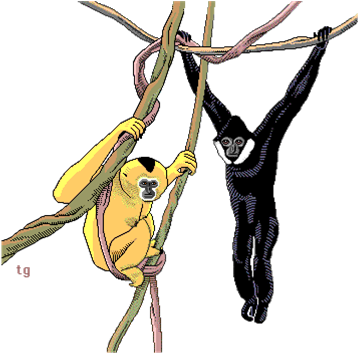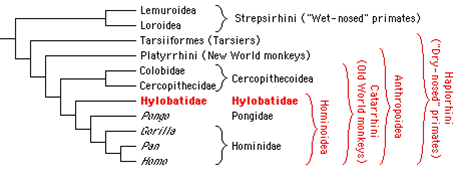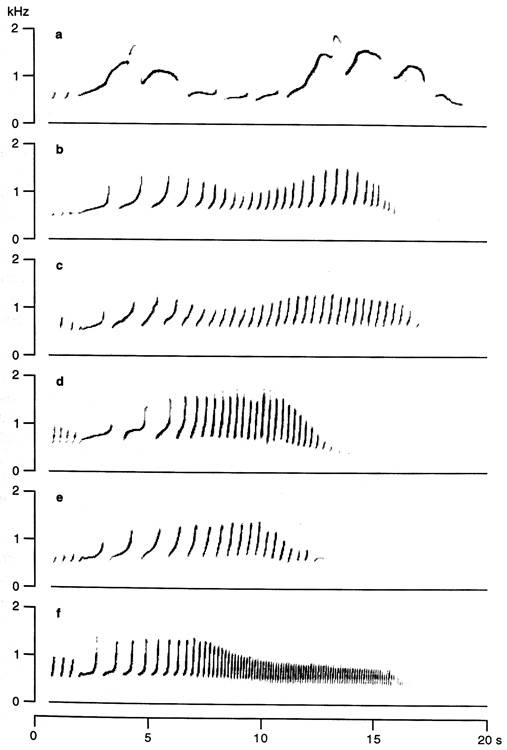December 22, 2004
Do hybrid whales sing hybrid songs?

Yesterday's NYT had an article by Andrew Revkin about "a solitary whale, species unknown, that has been tracked since 1992 in the North Pacific by a classified array of hydrophones used by the Navy to monitor enemy submarines". Apparently experts are convinced that the sounds are made by a whale, but the pattern is different from that of any known species, and tracking information indicates that there is only one individual calling out this way. The article indicates that the "most likely" explanation is that the whale is "a hybrid of a blue whale and another species".
You can hear the "52 Hz 'whale-like' signals" for yourself at the Vents Program Acoustic Monitoring site.
The idea that a hybrid whales should sing hybrid songs may surprise some people, though it shouldn't. We don't really know why hybrid animals show a mixture of complex physical characteristics inherited from their parents, and it's no harder in principle to explain how a hybrid animal might show a mixture of complex behavioral characteristics such as species-specific vocalizations. And in the specific case of hybrid vocalizations, there's a well-documented precedent: gibbons.
Gibbons are arboreal apes who live in the tropical rain forests of southeast Asia. There are 12 species in four subgenera, and the subgenera are apparently more different from one another genetically than humans are from chimps.
Here's the "family tree" showing the relationship of gibbons to us and the other primates. The gibbons are the Hylobatidae.

Gibbons travel mainly by swinging through the treetops ("brachiation"). Like 90% of bird species but only 3% of mammal species, they're monogamous, pair-bonded animals.
According to a discussion of gibbon singing at Thomas Geissman's Gibbon Research Lab:
All species of gibbons are known to produce elaborate, species-specific and sex-specific patterns of vocalisation often referred to as "songs" (Haimoff, 1984; Marshall & Marshall, 1976). Songs are loud and complex and are mainly uttered at specifically established times of day. In most species, mated pairs may characteristically combine their songs in a relatively rigid pattern to produce coordinated duet songs. Several functions have been attributed to gibbon songs, most of which emphasise a role in territorial advertisement, mate attraction and maintenance of pair and family bonds (Geissmann, 1999; Geissmann & Orgeldinger in press; Haimoff, 1984; Leighton, 1987).
Among the apes, only gibbons and (ambiguously) humans have pair bonding. Also, only gibbons and humans sing. According to Charles Darwin's theory that human language developed from love songs, this is not a coincidence.
Apparently, gibbon duetting is initiated and dominated by the female's contributions:
The most prominent song contribution of female gibbons consists of a loud, stereotyped phrase, the great call. Depending on species, great calls typically comprise between 6-100 notes, have a duration of 6-30 s. The shape of individual great call notes and the intervals between the notes follow a species-specific pattern.
A female song bout is usually introduced by a variable but simple series of notes termed the introductory sequence; it is produced only once in a song bout. Thereafter, great calls are produced with an interval of about 2 min. In the intervals, [are] so-called interlude sequences consisting of shorter, more variable phrases … The typical female song bout hence follows the sequential course ABCBCBCBC…,
Guy gibbons are by nature laconic, but open up a bit as a duet proceeds:
As a rule, adult males do not produce great calls, but "male short phrases" only. Whereas female great calls remain essentially unchanged throughout a song bout, males gradually build up their phrases, beginning with single, simple notes. As less simple notes are introduced, these notes are combined to increasingly complex phrases, reaching the fully developed form only after several minutes of singing …
During duet songs, mated males and females combine their song contributions to produce complex, but relatively stereotyped vocal interactions… Both pair partners contribute to an introductory sequence at the beginning of the song bout (A). Thereafter, interlude sequences (B) and great call sequences (C) are produced in successive alternation…
During great call sequences the male becomes silent and does not resume calling until near or shortly after the end of the female's great call, when he will produce a coda.
Gibbon species are (sometimes?) able to cross-breed, and often do so in zoos. The hybrid gibbon offspring produce hybrid songs, which are a predictable amalgam of the songs of the parents' species. The picture below shows six sound spectrograms, top to bottom. Each spectrogram shows time on the x axis (for twenty seconds), and frequency (here equal to perceived pitch height) on the y axis.
The topmost spectrogram (a) is a typical female "great call" of the white-handed gibbon, Hylobates lar. The bottom spectrogram (f) is a typical female "great call" of the gray gibbon, Hyobates muelleri. The intevening spectrograms are hybrid great calls from hybrid female gibbons, (b) and (c) from H. Muelleri x H. Lar crosses, and (d) and (e) from H. Lar x H. Muelleri crosses. The two versions of each type of hybrid call were produced by unrelated hybrid gibbons at different zoos:

You can learn more by reading the paper from which I took this illustration (Thomas Geissmann, "Gibbon Songs and Human Music from an Evolutionary Perspective", fig. 6), and you can listen to many sound samples at Thomas Geissmann's site.
Is there any analogy to human language here? If so, it must be a very abstract one, because there do not seem to be any connections at all between human genetic differences and human linguistic differences.
Posted by Mark Liberman at December 22, 2004 10:47 AM